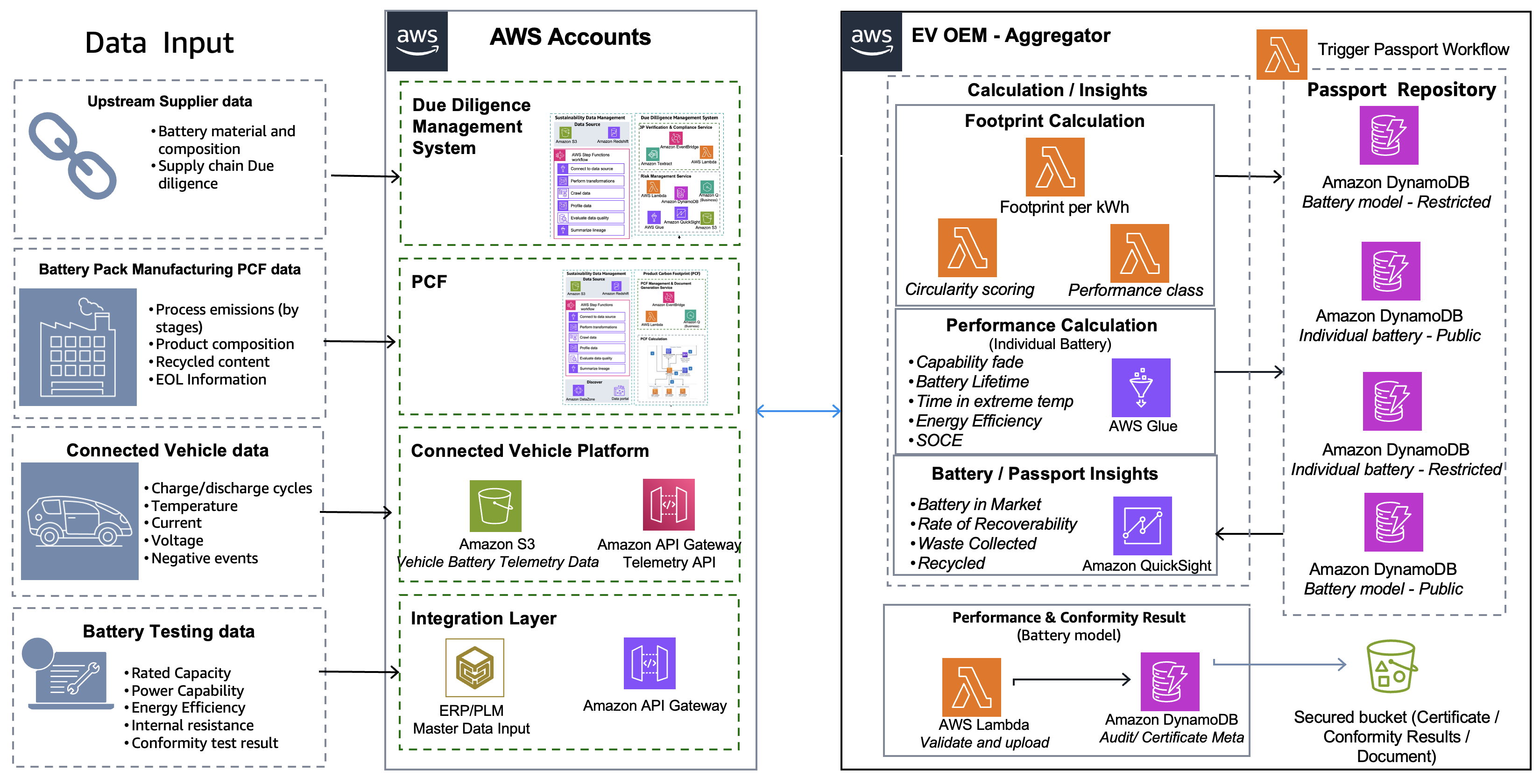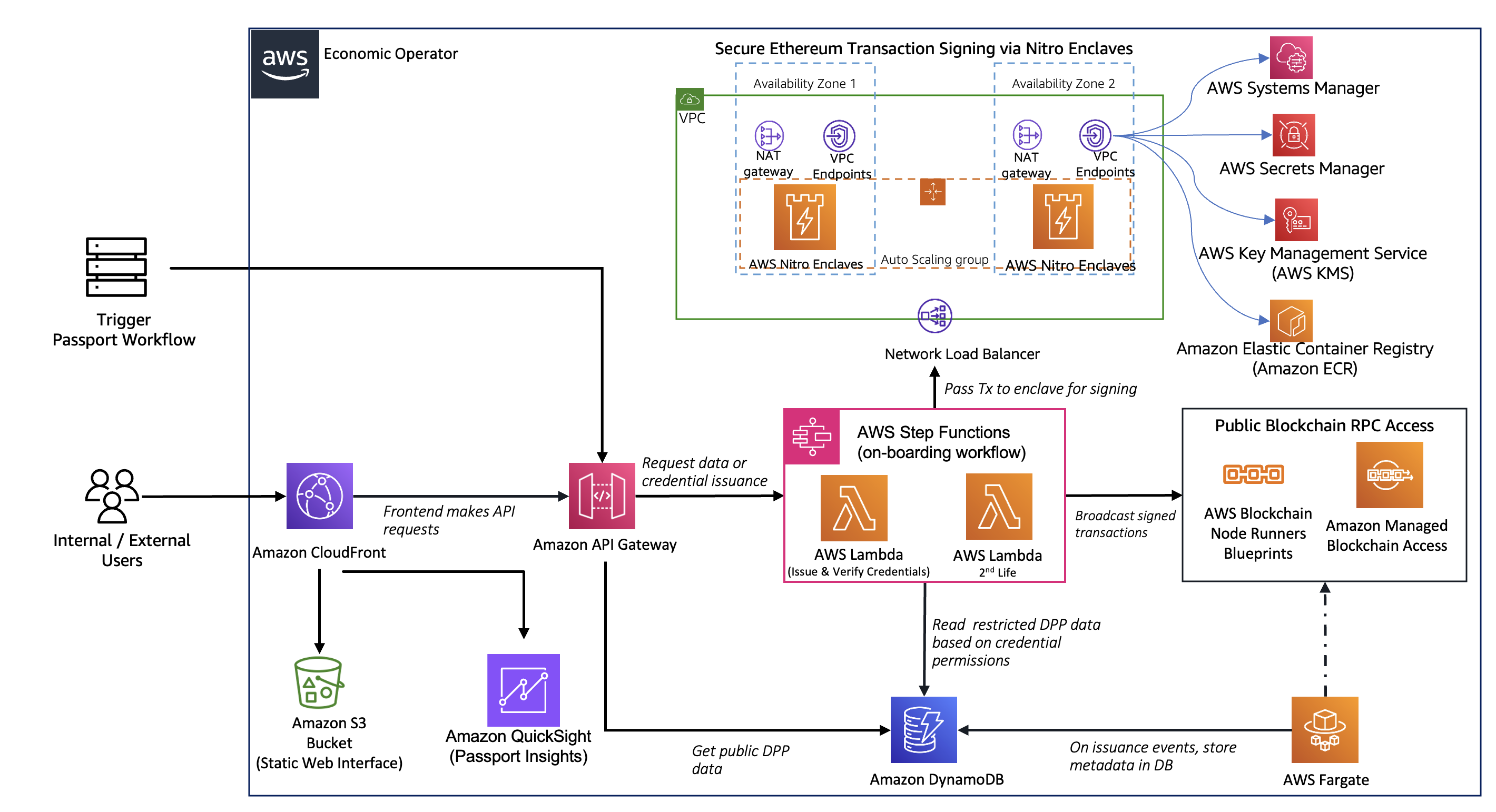AWS for Industries
Building a Battery Passport on AWS: Part 2
Battery Passports (as defined in Part 1 of our Building a Battery Passport blog) are crucial for economic operators such as automakers and battery energy storage system providers because they ensure compliance with the European Union’s Battery Regulation’s (Regulation (EU) 2023/1542) (EUBR) transparency, sustainability, and circular economy goals.[1] The Battery Passport forms a digital record providing detailed, traceable information on a battery’s composition, carbon footprint, supply chain due diligence, performance and durability, and circularity. Part 1 of our Building a Battery Passport blog defined the four essential building blocks for creating a Battery Passport, as highlighted in Figure 1 below, namely: (a) External Data Collection; (b) product carbon footprint (PCF); (c) Aggregator; and (d) Passport. Whereas Part 1 provided a deeper dive into the External Data Collection and PCF building blocks, this Part 2 blog delves into the Aggregator and Passport building blocks.
 Figure 1: Battery Passport Solution Building Blocks
Figure 1: Battery Passport Solution Building Blocks
3. Aggregator
In addition to the data collected from external sources, three other categories of data need to be obtained from various internal systems. These include: (a) identifiers and product data, symbols, labels; (b) documents of conformity; and (c) performance and durability data. While external data sources and PCF primarily focus on static battery model data, the focus of the aggregator is on individual battery data and mapping to battery models. In addition to static data, electric vehicle (EV) Battery Passports need to be regularly updated with battery performance data while the battery is in use.
The Aggregator serves as the central intelligence layer that:
- Processes and transforms data
- Performs necessary calculations
- Consolidates everything into a structured passport data repository
- Captures Conformity Assessment data (as defined below)
This solution building block includes passport-specific calculations and transformations, such as the calculation of the carbon footprint category ‘performance class’ (See EUBR Article 7(2)). The EUBR imposes new obligations on economic operators at various stages, and its regulatory implementation roadmap extends beyond 2027. As a result, the solution must continuously evolve and incorporate new regulatory obligations and changes. Therefore, centralizing all these changes in a single building block simplifies management. One of the key requirements fulfilled by the aggregator is a Conformity Assessment. A “Conformity Assessment” is defined by Article 2(1) of the EUBR as “the process demonstrating whether the sustainability, safety, labelling, information and due diligence requirements of EUBR have been fulfilled.” Specifically, Conformity Assessments are required by the EUBR to include “tests, measurements and calculations…made using reliable, accurate and reproducible methods…” for purposes of verifying that batteries comply with the EUBR requirements, such as due diligence policies and carbon footprint declaration.
Solution Approach
The Aggregator solution building block uses the data captured through External Data Collection and PCF building blocks. A battery ID is generated at the time of manufacturing when the QR code is imprinted on the battery pack. The Product Lifecycle Management (PLM) and Enterprise Resource Planning (ERP) system will provide crucial inputs as the individual battery ID and battery model, to the due diligence management system. This will trigger data collection for the Battery Passport from both internal and external systems. Refer to Figure 4 and 5 of Part 1 of this blog for more detail. Some of the key components of the solution include:
Calculations / Insights – After data collection, various functions are required to calculate values that will be entered into the Battery Passport. AWS Lambda functions can perform calculations such as carbon footprint calculations according to the draft carbon footprint delegated regulation, footprint by four lifecycle stages based on the battery pack’s kWh capacity, circularity rating, and performance class. Battery performance and durability data must be captured and categorized into two types, static and dynamic measurements. Static data includes information such as battery rated capacity, power capability, and internal resistance captured through battery testing systems along with Conformity Assessment results. Dynamic data includes information such as charge/discharge cycle, and negative events (Annex XIII 4d) captured from the electric vehicle connected vehicle platform. AWS Glue can be used to complete calculations as per regulations in bulk and update the Battery Passport data repository. This system must transform and calculate the data according to specified guidelines and the EUBR. For example, the State of Certified Energy (SOCE) must follow the conditions laid out in UN GTR No 22.
 Figure 2: Aggregator Solution Approach
Figure 2: Aggregator Solution Approach
Passport Registry – Once the values are calculated and transformed, the ready-to-access Battery Passport data is stored in Amazon DynamoDB. The Battery Passport data characteristics include public and restricted attributes, as well as battery model and individual battery attributes such as Battery ID and Manufacturing date. These attributes define the data storage and access strategy for the Battery Passport registry. To simplify the access control and access pattern required for a Battery Passport, four distinct DynamoDB tables are created. To demonstrate authenticity and transparency, when entering a record in DynamoDB, it will also trigger a workflow that inserts a hash of the data into the blockchain (refer to Passport section for more detail).
Performance & Conformity Result – All the certificates, conformity results, and reports will be validated and stored in a secured Amazon S3 bucket and can be accessed by a process or an application as needed. It will also store the audit information and certificate metadata in Amazon DynamoDB.
4. Passport
The final building block manages the actual Battery Passport issuance and accessibility. The German Institute for Standardization’s (DIN) specification, DIN DKE Spec 99100, highlights the mandatory data attributes needed for a Battery Passport and how many of them are designated for public access. The non-public data attributes restricted for authorized stakeholders.
The following are the key features for the Battery Passport building block:
- Issues first-life Battery Passports for new batteries with authenticity and transparency
- Manages varying access patterns for different user types
- Allow to transfer data for second-life Battery Passports when batteries are repurposed
- Use historic data to drive insight
In addition to battery status, performance data should be up to date. Any update will generate a new hash in the blockchain, ensuring authenticity and transparency for stakeholders. Optional performance parameters, as recommended in DIN DKE Spec 99100, could provide valuable insights into the secondary life of an electric vehicle or battery. The Battery Passport’s primary objective is to promote a circular economy. Therefore, additional data points such as State of Health (SoH) prediction, battery fault prediction, and indicators like Lithium Plating, SEI (Solid Electrolyte Interphase) growth, and accelerated degradation can be incorporated into the Battery Passport as valuable information for restricted access. Refer to blog Battery Digital Twin: The Future of Battery Intelligence for more information to drive value from battery data. As outlined in that blog post, battery insights drive significant value to the second-life sector. For instance, battery re-manufacturers can save considerable diagnostic time if cell fault information or prediction is shared as an additional attribute. Second-life operators can also utilize this information to accurately calculate battery residual value, minimizing financial risks.
Solution Approach
The Aggregator solution building blocks initiates the workflow to generate a Battery Passport for each battery, adhering to the World Wide Web Consortium’s standards. The Battery Passport data attributes are stored in Amazon DynamoDB tables, while the hash of these attributes is securely recorded on the blockchain. In this solution, the Battery Passport’s data integrity is verifiable via public blockchain such that anyone can verify the data has not been tampered with. Amazon Managed Blockchain (AMB) provides public blockchain nodes for Ethereum, which will be utilized to store the hash of Battery Passport data, ensuring transparency and authenticity. Alternatively, AWS Blockchain Node Runners is an infrastructure as code blueprint repository that can be used to deploy nodes to access multiple public blockchains such as Ethereum, Base, and Solana.
Scanning a QR code embedded with the uniform resource identifier (URI) (<economic operator/battery Id>) will grant access to the public data contained within the Battery Passport. Now you have a Battery Passport ready to be accessed from a QR code. For restricted data, stakeholders will receive Verifiable Credentials (VCs) to access the data. In accordance with the EUBR, any natural or legal person with a legitimate interest can access the restricted data. Therefore, an onboarding workflow will be implemented using AWS Step Function. This workflow will enable economic operators to verify the legitimacy of identity information and issue verifiable credentials to access specific restricted fields.
 Figure 3 Passport Solution Approach
Figure 3 Passport Solution Approach
When the battery transitions from its first to second life, the battery status changes from “original” to “repurposed,” “re-used,” or “remanufactured.” During this second life workflow, Lambda functions will retrieve the Battery Passport data from Dynamo DB and make it accessible to the second life Battery Passport provider for import.
In addition to accessing Battery Passport data externally, you may also need an internal access portal because multiple regulatory requirements necessitate tracking at the aggregate level. For instance, under the EUBR (Annex XII) the recycling efficiency targets, as defined, for lithium is 50% by 2027 and 80% by 2031. Similarly, pursuant to Article 8 of the EUBR, the requirement for the recycled content of lithium in a battery’s active material is 6% by 2031 and 12% by 2035. Amazon QuickSight can be utilized to generate insights, such as determining if the economic operator is on track to meeting future regulatory requirements. The Battery Passport data will also be shared with the Digital Product Passport (DPP) service provider, as identified by the EU.
Once the battery status changes to that of a waste battery, the responsibility for the Battery Passport fulfilment obligations is transferred either to the producer (Article 3(47)), the producer responsibility organization (Article 3 (49)), or the waste management operator. A Battery Passport expires if the battery is recycled (Article 77 (8)).
Conclusion
To evolve in line with business models, markets, and innovation, Battery Passport solutions should be flexible, dynamic, and market-driven. For instance, Battery Passports could combine mandatory data with optional data attributes to derive valuable insights and provide informative information about battery performance and battery packs for stakeholders in the circular economy.
The Digital Product Passport (DPP) is a broader initiative, and the Battery Passport is the first derived act. As per Regulation (EU) 2024/1781, Article 2 (28) defines DPP “as a set of product-specific data that includes information specified in the applicable delegated act adopted pursuant to Article 4 and is accessible electronically through a data carrier in accordance with Chapter III.” Under (EU) 2024/1781, the EU will, by Delegated Acts, establish product-specific eco-design criteria that may extend to vehicles and their components, such as tires. Therefore, it is crucial to establish a solid foundation so future solutions can support other product passports as well.
AWS has a Battery Passport demo and detailed solution approach. If you’re an economic operator, an ISV, or a consulting organization looking to build a Battery Passport solution, don’t hesitate to reach out to AWS’s Solution Architecture team for guidance or a workshop on building the Battery Passport. Alternatively, you can use the “Ask AWS” chat feature on the AWS home page to reach out to AWS Sales.
[1] The EUBR defines “economic operator” as the manufacturer, authorized representative, importer, distributor or the fulfillment service provider, or any other natural or legal person who is subject to obligations in relation to the manufacture, preparation for re-use, preparation for repurposing, repurposing or remanufacturing of batteries, the making available or the placing of batteries on the market, including online, or the putting of batteries into service in accordance with the EUBR.